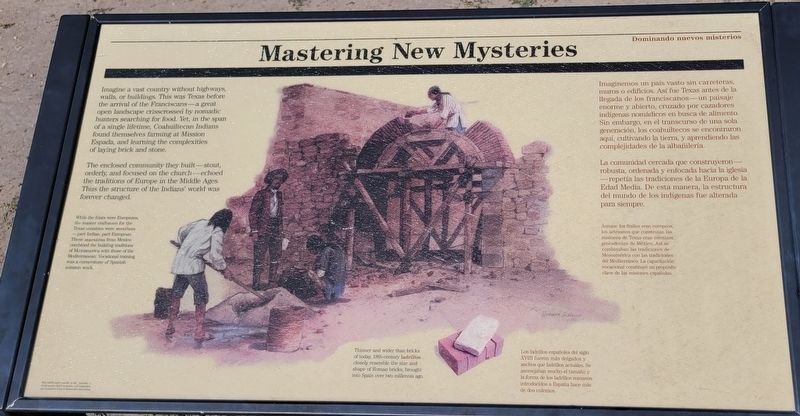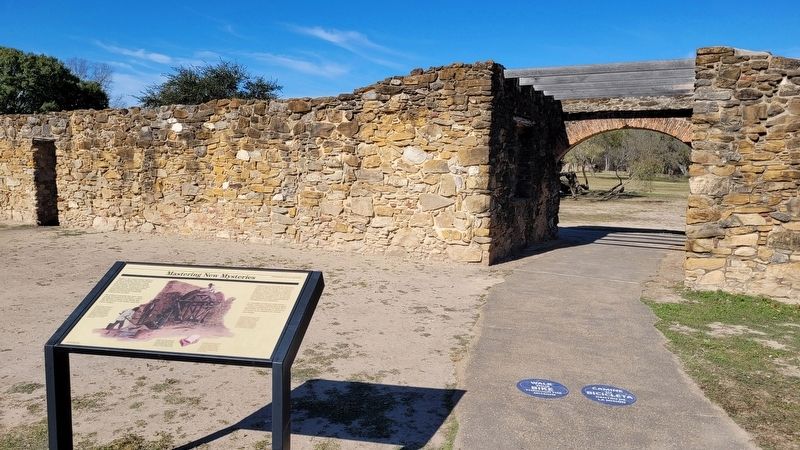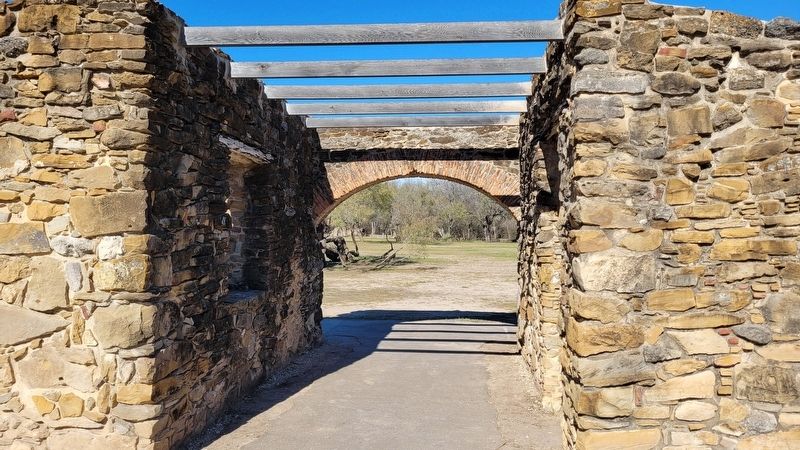Southside in San Antonio in Bexar County, Texas — The American South (West South Central)
Mastering New Mysteries
The enclosed community they built - stout, orderly, and focused on the church - echoed the traditions of Europe in the Middle Ages. Thus the structure of the Indians' world was forever changed.
While the friars were Europeans, the master craftsmen for the Texas missions were mestizos - part Indian, part European. These maestros from Mexico combined the building traditions of Mesoamerica with those of the Mediterranean. Vocational training was a cornerstone of Spanish mission work.
Captions
1. Thinner and wider than bricks of today, 18th-century ladrillos closely resemble the size and shape of Roman bricks, brought into Spain over two millennia ago.
[Spanish Text]
La comunidad cercada que construyeron - robusta, ordenada y enfocada hacia la iglesia -repetía las tradiciones de la Europa de la Edad Media. De esta manera, la estructura del mundo de los indígenas fue alterada para siempre.
Aunque los frailes eran europeos, los artesanos que construían las misiones de Texas eran mestizos procedentes de México. Así se combinaban las tradiciones de Mesoamérica con las tradiciones del Mediterráneo. La capacitación vocacional constituyó un propósito clave de las misiones españolas.
Subtítulos
1. Los ladrillos españoles del siglo XVIII fueron más delgados y anchos que ladrillos actuales. Se asemejaban mucho el tamaño y la forma de los ladrillos romanos introducidos a España hace más de dos milenios.
Erected by San Antonio Missions National Historical Park.
Topics. This historical marker is listed in these topic lists: Agriculture • Architecture • Forts and Castles • Native Americans.
Location. 29° 19.051′ N, 98° 27.03′ W. Marker is in San Antonio, Texas, in Bexar County. It is in Southside. Marker can be reached from the intersection of Espada Road and Camino Coahuilteca, on the left when traveling south. The marker is located on the central section of the Mission Espada grounds. Touch for map. Marker is at or near this postal address: 10040 Espada Road, San Antonio TX 78214, United States of America. Touch for directions.
Other nearby markers. At least 8 other markers are within walking distance of this marker. Espada Mission (a few steps from this marker); San Antonio Missions (a few steps from this marker); Granary (within shouting distance of this marker); The Church (within shouting distance of this marker); Building Sanctuaries (within shouting distance of this marker); Defending the Faithful (about 500 feet away, measured in a direct line); Mission San Francisco de la Espada (about 500 feet away); Community Life at Mission Espada (about 700 feet away). Touch for a list and map of all markers in San Antonio.
Also see . . . Mission Espada. San Antonio Missions - World Heritage
Mission San Francisco de la Espada was the first Spanish Mission in Texas. It was founded in 1690 as San Francisco de los Tejas near present-day Nacogdoches in East Texas. It was renamed as Mission San Francisco de la Espada when it moved to San Antonio in 1731. Distinctive Spanish design features can be seen in the church doorway, bell tower, and brick archways. Espada’s ranch, Rancho de las Cabras, is 23 miles south of the Mission and had as many as 1,262 head of cattle and 4,000 sheep. Mission Espada’s acequia is the nation’s oldest in continuous use. It still uses San Antonio River water to irrigate local crops today illustrating the connection the river makes between the past and the present.(Submitted on February 2, 2023, by James Hulse of Medina, Texas.)
Credits. This page was last revised on February 2, 2023. It was originally submitted on January 30, 2023, by James Hulse of Medina, Texas. This page has been viewed 72 times since then and 11 times this year. Photos: 1, 2, 3. submitted on February 2, 2023, by James Hulse of Medina, Texas.


